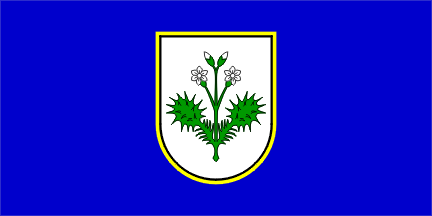
by Zeljko Heimer, 10 June 2004

Last modified: 2004-07-03 by dov gutterman
Keywords: zagreb | croatia | dubravica |
Links: FOTW homepage |
search |
disclaimer and copyright |
write us |
mirrors

by Zeljko Heimer, 10 June 2004
See also:
Other Sites:
Dubravica is a community in north-western corner of the Zagreb
County some 20 km NW of Zagreb.
Population about 5,500, the main vilage of the same name having
no more then about 500. In 1992 when the administrative reform in
Croatia wasd made the region was prescribed to be part of the
community of Hruševec Kupljenski, however this was against
the wish of the local population and such community was never
constituted. Rather the community of Dubravica was estabished
already in 1995.
The community symbol bacame a rather unusual endemic carnivorious
plant named in Croatian 'rosika' (in local dialect 'rozga'). The Coat of Arms is: Agrent a 'rosika' plant vert
with two thorny traps and with two flowers and two buds both of
the first. The flag is blue with the coat of arms bordered
golden. The Ceremonial Flag is a blue golfalon
with three rectangular tails containing oak ornaments, the coat
of arms is in the middle and the name of the community above in
two arches.
Sources: Puhacki orkestar Rozga, <www.orkestar-rozga.hr>,10.06.2004.
Prigorski Kaj, mjesecnik Grada Zaprešica, 2003
Zeljko Heimer, 10 June 2004
The plant seems to be a Drosera. The genus Drosera
is the type of the family Droseraceae. Droseras are
small plants which trap insects on their leaves, covered with
sticky glandulous hairs, and slowly "digest" them by
releasing proteolytic enzymes. The droseras lives in marshes and
peat bogs, where their dense colonies can form kinds of floating
mats. The most common drosera is Drosera rotundifolia.
All droseras are endangered and protected, although it is
difficult to avoid trampling them in places where they are very
common, as for instance the Lofoten island in northern Norway.
Another plant of the same family is Aldrovandia vesiculosa,
an insectivorous plant which was already marked RRR (that is very
very rare) in the plant guides of the beginning of the century
and might have disappeared from France today. Digesting insects
help these plants to survive in a very acid, poor in nitrogen
environment.
In English, the common name of the drosera is sundew. In French,
the traditional name of the drosera is rossolis, which
seems to be cognate of rosika and rozga. The
name rossolis was derived from Latin ros solis,
sun dew. The plant is also called rosee-du-soleil (lit.,
sundew) and herbe-a-la-rosee (lit., dew herb). The
scientific name Drosera was of course coined by Carl
Linne, and means "covered with dew" in Ancient Greek.
This sun dew is made by the droplets of glue secreted by the
hairs of the plants, which glisten in